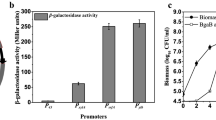Abstract
Most expression systems are based on Escherichia coli as the host strain because of the large availability of all kinds of vector plasmids. However, aside from the obvious advantages of E. coli systems, serious problems can occur during the process of heterologous gene expression and purification. Therefore, low expression rates, formation of inclusion bodies, improper protein-folding, and/or toxicity problems might enforce changing the expression host. Here we describe the construction of two new vectors, pBSMuL1 and pBSMuL2, for overexpression and secretion of heterologous proteins in Bacillus subtilis as an alternative expression host. The new plasmids combine several advantages in comparison to available Bacillus expression systems: an appropriate multiple cloning site consisting of 13 unique restriction sites, one (pBSMuL1) or two (pBSMuL2) strong constitutive promoters, a high efficient signal sequence for protein secretion, and the possibility to express proteins as His-tagged fusions for easy detection and purification. We have demonstrated the applicability of the novel vector plasmids for the production and purification of the heterologous cutinase from Fusarium solani pisi.



Similar content being viewed by others
Literature Cited
Baneyx F (1999) Recombinant protein expression in Escherichia coli. Curr Opin Biotechnol 10:411–421
Bron S, Luxen E (1985) Segregational instability of pUB110-derived recombinant plasmids in Bacillus subtilis. Plasmid 14: 235–244
Dartois V, Coppée JY, Colson C, Baulard A (1994) Genetic analysis and overexpression of lipolytic activity in Bacillus subtilis. Appl Environ Microbiol 60:1670–1673
Eggert T, Brockmeier U, Dröge MJ, Quax WJ, Jaeger KE (2003) Extracellular lipases from Bacillus subtilis: Regulation of gene expression and enzyme activity by amino acid supply and external pH. FEMS Microbiol Lett 225:319–324
Egmond MR, de Vlieg J (2000) Fusarium solani pisi cutinase. Biochimie 82:1015–1021
Jongbloed JDH, Antelmann H, Hecker M, Nijland R, Bron S, Airaksinen U, et al. (2002) Selective contribution of the twin-arginine translocation pathway to protein secretion in Bacillus subtilis. J Biol Chem 277:44068–44078
Lam KH, Chow KC, Wong WK (1998) Construction of an efficient Bacillus subtilis system for extracellular production of heterologous proteins. J Biotechnol 63:167–177
Nagarajan V, Albertson H, Chen M, Ribbe J (1992) Modular expression and secretion vectors for Bacillus subtilis. Gene 114:121–126
Schallmey M, Singh A, Ward OP (2004) Developments in the use of Bacillus species for industrial production. Can J Microbiol 50:1–17
Schmid RD, Alberghina L, Verger R (1991) Lipases-structure, function and genetic engineering. GBF Monographs VCH Weinheim 16:243–251
Tjalsma H, Bolhuis A, Jongbloed JDH, Bron S, van DijL JM (2000) Signal peptide-dependent protein transport in Bacillus subtilis: A genome-based survey of the secretome. Microbiol Mol Biol Rev 64:515–547
van der Vossen JMBM, van der Lelie D, Venema G (1987) Isolation and characterization of Streptococcus cremoris Wg2-specific promoters. Appl Environ Microbiol 53:2452–2457
van Wely KHM, Swaving J, Freudl R, Driessen AJM (2001) Translocation of proteins across the cell envelope of Gram-positive bacteria. FEMS Microbiol Rev 25:437–454
Winkler UK, Stuckmann M (1979) Glycogen, hyaluronate, and some other polysaccharides greatly enhance the formation of exolipase by Serratia marcescens. J Bacteriol 138:663–670
Zyprian E, Matzura H (1986). Characterization of signals promoting gene expression on the Staphylococcus aureus plasmid pUB110 and development of a gram-positive expression system. DNA 5:219–225
Acknowledgments
One author (U. B.) was supported by a scholarship from the European Graduate College 795 entitled Regulatory Circuits in Cellular Systems: Fundamentals and Biotechnological Applications, which was funded by the Deutsche Forschungsgemeinschaft.
Author information
Authors and Affiliations
Corresponding author
Rights and permissions
About this article
Cite this article
Brockmeier, U., Wendorff, M. & Eggert, T. Versatile Expression and Secretion Vectors for Bacillus subtilis. Curr Microbiol 52, 143–148 (2006). https://doi.org/10.1007/s00284-005-0231-7
Received:
Accepted:
Published:
Issue Date:
DOI: https://doi.org/10.1007/s00284-005-0231-7




